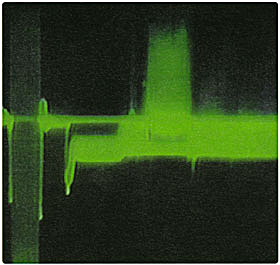| Zeitschrift Umělec 2001/3 >> Tomorrow`s World | Übersicht aller Ausgaben | ||||||||||||
|
|||||||||||||
Tomorrow`s WorldZeitschrift Umělec 2001/301.03.2001 Karel Císař | audio-video | en cs |
|||||||||||||
|
When Jonathan Romney, art critic for the Guardian, had to
decide which works to highlight from the blockbuster exhibition Apocalypse in London last year, he singled out the short film flex by young British artist Chris Cunningham, who was showing his own work for the first time. Before Apocalypse he mostly shot music videos and commercials, and prior to that he made special effects for films like Alien 3, Judge Dredd and Kubrick’s planned A. I. Artificial Intelligence. Nevertheless Cunningham was not an unknown name to art critics. At the end of 1999 he was included in the show Exit at London’s Chisenhale Gallery alongside names like Fischli and Weiss, and Bruce Nauman. There he exhibited the music video Windowlicker, which he’d originally made for Aphex Twin. A year later this piece — along with Come to Daddy, another Aphex Twin video — was presented in Rome at the event Video Vibe: Art, Music and Video in the UK. And now this year flex, the music video All is Full of Love made for Björk and the brand new film Monkey Drummer featuring music by Aphex Twin are all being exhibited at the Venice Biennale. It seems that Richard D. James, a.k.a. Aphex Twin, cult figure on the British electronic music scene, has found an ideal partner in Cunningham. Their dates of birth are only a few months apart, both launched into their professional career at a young age, and they even resemble each other. But most importantly they possess an obsessive interest in human corporality and its potential alterations. For example, instead of a pair of lungs on the back cover of one of his records from 1995, Aphex Twin inserted his well-known logo into a sketch of a human torso in place of a pair of lungs. Together with the title Ventolin — an inhaler whose unpleasant sound opens the record — this clearly references the artist’s asthma. A year later, he used a photograph of a tombstone inscribed with the name Richard James — it was the name of his brother, who died before Richard David James was born and whose name the younger child inherited. In 1997 and 1999, with Cunningham’s help, Aphex Twin transformed and multiplied his own image, which appeared in the place of the children’s faces on the cover of Come to Daddy, and as the face of a sexy woman in a bikini in Windowlicker. He also appears, in the same disguises, in the music videos Cunningham made for these records. Unlike the album covers, the videos required more than computer manipulation to achieve their hybrid effect: The group of teenage girls wore latex masks of Aphex Twin’s demonic face (which also appears in a portrait by last year’s Turner Prize winner Wolfgang Tillmans), as did the two sexy black women in Windowlicker. Note the contrast, incidentally, to the album cover, which featured one white female. This skin-color swapping is not incidental: In Cunningham’s music video Aphex Twin morphes into two black women, and likewise they transform into Aphex in a parody of stereotypical rap videos. Such subversive approaches are not uncommon among artists on the seminal electronic label Warp. Another such producer is Tom Jenkinson, a.k.a. Squarepusher, who has recently released the new album Go Plastic, and who was present at 100 Club on Oxford Street on June 5. While radical experimenter Aphex Twin tries to present his idea of pop music (the Windowlicker EP made it into the official British Top Twenty), Squarepusher opens his new album, as well as his latest concert, with the original song “My Red Hot Car,” a two-step garage including explicit lyrics that make reference to Craig David. Squarepusher’s radicalism lies mostly in the way he mixes extremely fast break-beats and jazz riffs with elements of konkrete musik. The same could be said for the unbelievable DJ who opened the concert, who was none other than Chris Cunnignham (and who also made the music video for Squarepusher’s “Come On My Selector”). The three artists primarily share a systematic interest in breaking all limits, not only the horizontal limits that separate music, sound and noise but also the vertical limits dividing sound and image. In addition to Cunningham’s music videos and graphic design by Designers Republic and Kleber, this is also effected by means of color-coding used for individual tracks on the album Selected Ambient Works II by Aphex Twin, who confesses to having synesthesia, a rare condition in which the stimulation of one sense causes an additional perception in a different sense or senses. After a six-year hiatus, Aphex Twin is to release his new album, DrukQs, on October 22.
01.03.2001
Empfohlene Artikel
|
|||||||||||||









Kommentar
Der Artikel ist bisher nicht kommentiert wordenNeuen Kommentar einfügen